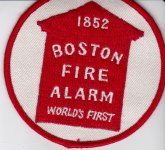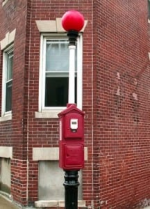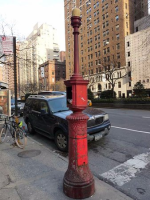- Joined
- Mar 17, 2022
- Messages
- 50
www.nhregister.com /news/article/Fake-fire-alarm-box-sparks-confusion-with-Derby-17596006.php

Fire Chief David Lenart spotted a fake fire call box in Derby last Friday. The utility company that owns the pole it was attached to has since removed it.
Contributed photo
DERBY — Fire Chief David Lenart had a literal false alarm Friday near the corner of Hawthorne and Nutmeg avenues.
Lenart was driving past the site when he spotted a fake fire alarm pull box mounted to a utility pole.
"I have no idea who could have set it up," Lenard said. "I would assume it's somebody in the neighborhood."
While Lenart said the device wasn't operational, it was important to remove it as soon as possible since it could trick people into using it for emergencies, he said.
"It's just dangerous," he said. "In an emergency, a person might see it, and it says 'Emergency' on it. It looks completely real. And God forbid they see it and during an emergency they think 'Oh, I can just pull that and the fire department will come and to their surprise, it's fake."
But while an ordinary resident would have been fooled, Lenart said a trained eye could spot clues that it was a fake. Real fire alarm pull boxes are made out cast iron to withstand the elements, he said. This one was made of plastic and the color was a much brighter shade of red. A real box also would have had a hook inside to pull the alarm. This one had a keypad like a phone.
The utility company that owns the pole has since removed it.
Ironically, Lenart said, utility companies have had problems with real fire call boxes being stolen, not fake ones being installed.
"At this point, they're a very hot collectible in the fire service," Lenart said.
Prices for one, he said can go for $500. One alarm with a phone on eBay is selling for $800. Another one more similar to the cast iron alarm is selling for $625.
Derby removed its network of fire alarm pull boxes a few years ago, he said. The antiquated system used telegraph lines to alert the nearby fire department. The alarms, Lenart said, were still operational when they were removed.
Fire alarm pull boxes were first installed in Boston in 1852 according to the National Museum of American History. Connected by telegraph wires, the boxes were triggered by someone cranking out the signal to a central location which would then dispatch a firefighter team. It was a quick way for fire departments to respond in an era before telephones.
But telephones gradually made the boxes redundant and by 1968, the U.S. had adopted the current 911 emergency system.
The boxes were susceptible to false alarms he said, since people would routinely trigger them for fun, according to Lenart. But they weren't just for fires. They also pulled double duty as civil defense emergency alarms during the Cold War, he said. The alarms would be triggered in case of an air raid.
Most young people he said, would not know what these boxes were used for. But for older residents, they were one of the few ways they could get help in a time when people weren't as connected as they are now.
"The average citizen in town relied on those boxes, because they knew that all you had to do was pull that box and someone was coming," he said.
False alarm: Fake fire call box removed in Derby
Eddy Martinez 11/23/2022
Fire Chief David Lenart spotted a fake fire call box in Derby last Friday. The utility company that owns the pole it was attached to has since removed it.
Contributed photo
DERBY — Fire Chief David Lenart had a literal false alarm Friday near the corner of Hawthorne and Nutmeg avenues.
Lenart was driving past the site when he spotted a fake fire alarm pull box mounted to a utility pole.
"I have no idea who could have set it up," Lenard said. "I would assume it's somebody in the neighborhood."
While Lenart said the device wasn't operational, it was important to remove it as soon as possible since it could trick people into using it for emergencies, he said.
"It's just dangerous," he said. "In an emergency, a person might see it, and it says 'Emergency' on it. It looks completely real. And God forbid they see it and during an emergency they think 'Oh, I can just pull that and the fire department will come and to their surprise, it's fake."
But while an ordinary resident would have been fooled, Lenart said a trained eye could spot clues that it was a fake. Real fire alarm pull boxes are made out cast iron to withstand the elements, he said. This one was made of plastic and the color was a much brighter shade of red. A real box also would have had a hook inside to pull the alarm. This one had a keypad like a phone.
The utility company that owns the pole has since removed it.
Ironically, Lenart said, utility companies have had problems with real fire call boxes being stolen, not fake ones being installed.
"At this point, they're a very hot collectible in the fire service," Lenart said.
Prices for one, he said can go for $500. One alarm with a phone on eBay is selling for $800. Another one more similar to the cast iron alarm is selling for $625.
Derby removed its network of fire alarm pull boxes a few years ago, he said. The antiquated system used telegraph lines to alert the nearby fire department. The alarms, Lenart said, were still operational when they were removed.
Fire alarm pull boxes were first installed in Boston in 1852 according to the National Museum of American History. Connected by telegraph wires, the boxes were triggered by someone cranking out the signal to a central location which would then dispatch a firefighter team. It was a quick way for fire departments to respond in an era before telephones.
But telephones gradually made the boxes redundant and by 1968, the U.S. had adopted the current 911 emergency system.
The boxes were susceptible to false alarms he said, since people would routinely trigger them for fun, according to Lenart. But they weren't just for fires. They also pulled double duty as civil defense emergency alarms during the Cold War, he said. The alarms would be triggered in case of an air raid.
Most young people he said, would not know what these boxes were used for. But for older residents, they were one of the few ways they could get help in a time when people weren't as connected as they are now.
"The average citizen in town relied on those boxes, because they knew that all you had to do was pull that box and someone was coming," he said.



